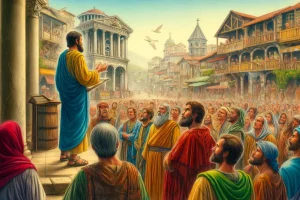
The Book of Amos
The Book of Amos is one of the Twelve Minor Prophets in the Hebrew Bible/Old Testament, notable for its strong social justice themes. Here are some brief, quick facts about this book:
- Authorship: Amos, who identifies himself as a shepherd from Tekoa in Judah, is the author. He was active around 760-750 BCE.
- Historical Context: Amos preached during the reigns of King Uzziah of Judah and King Jeroboam II of Israel, a period of relative prosperity but also of significant social inequality and moral decay.
- Themes:
- Social Justice and Righteousness: Amos is particularly noted for his emphasis on social justice, condemning the exploitation of the poor and defenseless by the upper classes.
- Divine Judgment: The prophet warns of imminent divine judgment due to the people’s unethical and idolatrous practices.
- The Universality of God: Amos emphasizes that God’s sovereignty extends beyond Israel to all nations, whom He holds to the same standards of justice and righteousness.
- Structure: The book can broadly be divided into three parts:
- Chapters 1-2: Oracles against Israel and neighboring nations.
- Chapters 3-6: Sermons and woe oracles against Israel’s injustices.
- Chapters 7-9: Visions of God’s judgment and a final promise of restoration.
- Key Passages:
- Amos 5:24: “But let justice roll down like waters, and righteousness like an ever-flowing stream.” This verse epitomizes Amos’s message and his call for ethical behavior.
- Literary Features: Amos uses vivid imagery, poignant metaphors, and direct speech to deliver his message, making the text powerful and rhetorically effective.
- Theological Significance: The book challenges the notion that ritualistic worship is sufficient to please God, emphasizing ethical living and social justice as true expressions of piety.
The Book of Amos is a profound prophetic text that offers stark warnings about social injustice and divine accountability. Amos, a shepherd from Tekoa in the southern kingdom of Judah, directs most of his prophetic ministry towards the northern kingdom of Israel during a time of economic prosperity and social inequality. Here is a detailed analysis of the Book of Amos, exploring its historical context, structure, key themes, and overall significance.
1. Historical Context
Amos prophesied during the mid-8th century BCE, specifically around 760-750 BCE, a period marked by the reign of King Jeroboam II in Israel and King Uzziah in Judah. This was a time of significant territorial expansion and economic prosperity for Israel, but it was also a period characterized by rampant social injustices, religious complacency, and moral decay. Amos’s messages are directed at a society where the wealthy and powerful were exploiting the poor, and religious piety was overshadowed by corruption and idolatry.
2. Structure
The Book of Amos can be divided into three main sections, each with a distinct focus:
- Chapters 1-2: Oracles against the surrounding nations and Israel, setting a tone of divine judgment that is universal and impartial.
- Chapters 3-6: These chapters contain a series of speeches and woe oracles highlighting Israel’s social sins and the inevitability of divine punishment.
- Chapters 7-9: This section features five visions that Amos receives, which graphically depict the judgment coming upon Israel, concluding with a promise of restoration for the remnant of the people.
3. Major Themes
- Justice and Righteousness: Amos emphasizes that true piety is not expressed through ritualistic worship alone but through ethical behavior—justice and righteousness. His famous declaration, “But let justice roll down like waters, and righteousness like an ever-flowing stream” (Amos 5:24), captures this theme succinctly.
- Divine Judgment and Mercy: Throughout the book, Amos presents God as a just judge who will not tolerate injustice or idolatry. However, even in the stern warnings, there is a glimmer of mercy and restoration, suggesting God’s enduring commitment to His covenant people.
- The Sovereignty of God Over All Nations: Amos underscores that God holds all nations accountable to His standards of justice and righteousness, not just Israel.
4. Literary Features
Amos uses powerful imagery, metaphors, and rhetorical questions to engage his audience. His language is direct and often harsh, designed to jolt his listeners out of complacency. The use of visions, symbols (such as the plumb line and the basket of summer fruit), and reports of divine speech enhance the dramatic and urgent tone of his message.
5. Theological Contributions
Amos challenges the assumption that the chosen status of Israel would protect them from God’s judgment. Instead, he argues that their election brings greater responsibility for ethical integrity. This theological stance redefines the nature of the relationship between God and His people, emphasizing moral accountability over ceremonial observance.
6. Contemporary Relevance
The Book of Amos is incredibly relevant in modern contexts, addressing issues like social inequality, economic exploitation, and the need for integrity in religious practices. It calls for a critical evaluation of societal norms and behaviors, encouraging a return to social justice as a fundamental religious practice.
In summary, the Book of Amos serves as a poignant reminder of the ethical demands of faith and the universality of divine justice. It challenges both ancient and modern readers to reflect on their own societies and to reform them in ways that align with divine standards of justice and righteousness.
Tag:8th century BCE, Amos, Book of the Twelve, divine judgment, divine sovereignty, ethical behavior, exploitation, Israel, Jeroboam II, justice, minor prophets, moral accountability, northern kingdom, Old Testament, oracles against nations, prophecy, religious corruption, repentance, Righteousness, Social Justice, Tekoa, visions



